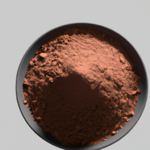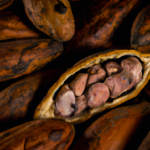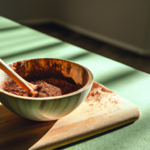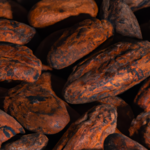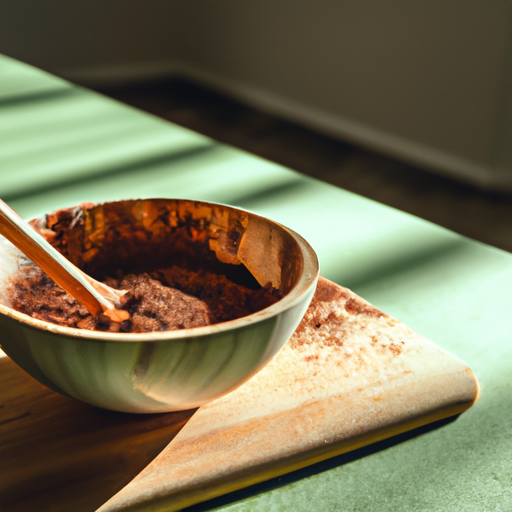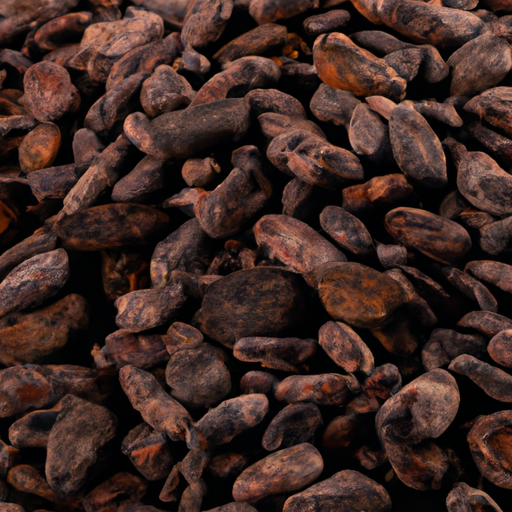Were you aware that raw cacao powder has the ability to enhance your mood and produce a natural high? This is factual! Recent research shows that raw cacao includes specific compounds that can trigger the release of endorphins and serotonin, the chemicals in our brain that make us feel good.
As someone who has always been interested in exploring natural ways to enhance my well-being, I was intrigued by the potential of raw cacao powder. In this article, I will guide you through the science behind raw cacao powder and how to incorporate it into your daily routine.
We will also delve into different recipes, dosages, and the importance of sourcing high-quality raw cacao. By the end, you will have a comprehensive understanding of how to use raw cacao powder to elevate your mood and overall wellness.
So let’s embark on this journey together and discover the incredible benefits of raw cacao powder.
Understanding the Science Behind Raw Cacao Powder
To fully appreciate the effects of raw cacao powder, it’s important to understand the science behind its mood-enhancing properties. Raw cacao powder contains a variety of compounds that can positively impact our mood. Theobromine, for example, acts as a natural stimulant, promoting alertness and focus. Phenylethylamine, also known as the ‘love molecule,’ can boost feelings of happiness and euphoria. Anandamide, often referred to as the ‘bliss molecule,’ enhances relaxation and contentment. By exploring the effects of raw cacao powder on brain chemistry, we gain insight into how it contributes to a positive mood and overall well-being.
Now, let’s delve into how to incorporate raw cacao powder into your daily routine.
Incorporating Raw Cacao Powder into Your Daily Routine
Start your day off right by adding a sprinkle of this magical ingredient to your morning smoothie or oatmeal. Raw cacao powder is not only delicious, but it’s also packed with essential nutrients that can benefit your overall health. Understanding the nutritional content of raw cacao powder is crucial for maximizing its benefits.
It is rich in antioxidants, which can help protect your body against free radicals and reduce inflammation. Additionally, raw cacao powder is a good source of iron, magnesium, and fiber.
To incorporate raw cacao powder into your daily routine, consider trying these ideas:
- Mix it into your favorite smoothie for a rich chocolate flavor.
- Add it to your morning oatmeal for a nutritious and indulgent breakfast.
- Sprinkle it over fresh fruits for a healthy and satisfying dessert.
- Blend it with almond milk and a sweetener of your choice for a delicious hot chocolate alternative.
Understanding the nutritional benefits and exploring different preparation methods of raw cacao powder can open up a world of possibilities in the kitchen. In the next section, we will delve into various raw cacao recipes to further enhance your culinary experience.
Exploring Different Raw Cacao Recipes
Discover the joy of exploring an array of delectable raw cacao recipes that will tantalize your taste buds and leave you craving for more.
When it comes to raw cacao, the possibilities are endless. Not only can you create mouthwatering desserts like chocolate truffles and fudgy brownies, but you can also experiment with raw cacao in savory dishes.
Imagine adding a sprinkle of raw cacao powder to a chili recipe for a rich, deep flavor or incorporating it into a mole sauce for a unique twist. The bold, bitter notes of raw cacao can complement a variety of ingredients, allowing you to create unique flavor combinations that will impress even the most discerning palate.
Understanding the importance of quality and sourcing is crucial when working with raw cacao, so let’s delve into that next.
Understanding the Importance of Quality and Sourcing
When it comes to using raw cacao powder, it’s crucial to prioritize quality and sourcing.
One important aspect is choosing organic and fair trade raw cacao powder. This ensures that the product is free from harmful pesticides and supports farmers in developing countries.
Additionally, checking for raw and unprocessed varieties is essential. This guarantees that the cacao retains its nutritional integrity.
Lastly, supporting sustainable and ethical farming practices is vital. It helps protect the environment and ensures that farmers are fairly compensated for their hard work.
Choosing Organic and Fair Trade Raw Cacao Powder
To fully savor the rich flavors and support ethical practices, it’s important to choose organic and fair trade raw cacao powder.
Choosing organic cacao ensures that it has been produced without the use of synthetic pesticides, herbicides, or genetically modified organisms. This not only benefits our health but also protects the environment from harmful chemicals.
Fair trade certification guarantees that the cacao farmers receive fair wages and work under safe conditions, promoting social justice and economic sustainability.
By purchasing organic and fair trade raw cacao powder, you’re making a conscious choice to support sustainable farming practices and empower small-scale farmers. These certifications represent a commitment to quality and authenticity, allowing you to enjoy your cacao guilt-free.
Now, let’s move on to checking for raw and unprocessed varieties.
Checking for Raw and Unprocessed Varieties
If you’re looking for a more authentic and unadulterated experience, consider opting for varieties of cacao that have not undergone extensive processing. When checking for organic certification, look for labels that indicate the product is certified organic by a reputable organization. This ensures that the cacao powder has been produced without the use of synthetic pesticides or fertilizers. Additionally, finding raw cacao powder in local stores can be a great way to support small businesses and reduce your carbon footprint. Look for specialty stores or health food stores that prioritize carrying organic and raw products. As you explore these options, it’s important to be aware that not all raw cacao powders are created equal. Some may still undergo minimal processing, so reading labels and researching the brand’s production methods can provide valuable information. By choosing raw and unprocessed cacao powder, you can savor the true flavors and potential health benefits while supporting sustainable and ethical farming practices.
Supporting Sustainable and Ethical Farming Practices
By opting for cacao varieties that have undergone minimal processing, I can indulge in the pure essence of the cocoa bean while supporting farming practices that are both sustainable and ethical.
Ethical sourcing and sustainable farming are crucial considerations when choosing raw cacao powder. Look for certifications such as fair trade or organic, which ensure that the farmers are paid fair wages and use environmentally friendly practices.
Additionally, supporting small-scale farmers who employ sustainable farming methods helps protect the environment and promotes biodiversity. By consciously selecting raw cacao powder from these sources, I can enjoy its rich flavor and health benefits while contributing to a more sustainable and ethical cocoa industry.
Moving forward to mindful consumption and dosage, it is important to understand the proper ways to incorporate raw cacao powder into my routine.
Mindful Consumption and Dosage
Mindful consumption and finding the perfect dosage are key factors in unlocking the full potential of raw cacao powder for an elevated experience. When it comes to mindful dosing, responsible use is essential. Here are three important considerations to keep in mind:
-
Start with a low dose: Begin with a small amount of raw cacao powder to gauge your body’s reaction and tolerance. This allows you to gradually increase the dosage for optimal effects.
-
Listen to your body: Pay attention to how your body responds to different dosages. If you experience any discomfort or unwanted side effects, adjust the amount accordingly.
-
Be consistent: Consistency is key when it comes to mindful consumption. Establish a regular routine and stick to it to experience the long-term benefits of raw cacao powder.
By being mindful of your dosing and consumption, you can fully harness the potential of raw cacao powder.
Transitioning into the subsequent section, let’s explore how pairing raw cacao powder with other mood-enhancing ingredients can enhance the overall experience.
Pairing Raw Cacao Powder with Other Mood-Enhancing Ingredients
Combining raw cacao powder with other mood-enhancing ingredients can elevate your overall experience and enhance the positive effects.
Did you know that a study found that consuming dark chocolate, which contains cacao, can lead to increased serotonin levels, promoting feelings of happiness and well-being?
When it comes to mood-boosting smoothie recipes, adding raw cacao powder can take your creations to the next level. Consider blending it with ingredients like bananas, which are rich in tryptophan and can further boost serotonin production.
Additionally, adding a sprinkle of cinnamon can help regulate blood sugar levels and enhance energy levels throughout the day.
By experimenting with different combinations, you can create delicious and nutritious smoothies that not only taste great but also provide a natural mood uplift.
Now, let’s explore the potential health benefits of raw cacao powder.
Exploring the Potential Health Benefits of Raw Cacao Powder
Now that we’ve explored the potential mood-enhancing effects of pairing raw cacao powder with other ingredients, let’s delve into the potential health benefits of raw cacao powder itself.
-
Rich in antioxidants: Raw cacao powder is packed with powerful antioxidants that help protect our cells from damage caused by free radicals.
-
Improved heart health: Studies have shown that consuming raw cacao powder may help lower blood pressure, reduce inflammation, and improve overall cardiovascular health.
-
Enhanced brain function: The flavonoids found in raw cacao powder have been linked to improved cognitive function and may even protect against age-related cognitive decline.
-
Increased energy and mood: Raw cacao powder contains natural stimulants, such as theobromine, which can boost energy levels and promote a positive mood.
However, it’s important to note that raw cacao powder should be consumed in moderation. Excessive consumption may lead to potential side effects such as digestive issues and jitteriness. A recommended dosage is about 1-2 tablespoons per day.
Transitioning into the subsequent section, let’s now explore how incorporating raw cacao powder into a holistic lifestyle can further enhance its benefits.
Incorporating Raw Cacao Powder into a Holistic Lifestyle
To fully experience the amazing benefits of raw cacao powder, it’s time for you to embrace a holistic lifestyle and discover the endless possibilities it brings to your well-being. One way to incorporate raw cacao powder into your daily routine is by using it in baking. Its rich flavor adds a decadent twist to cookies, cakes, and brownies, while its natural antioxidants provide a health boost. Another benefit of raw cacao powder is its ability to act as a natural energy booster. Its high magnesium content helps to increase energy levels and reduce fatigue.
Incorporating raw cacao powder into a holistic lifestyle can be visualized through a simple table:
| Morning Routine | Evening Routine |
|---|---|
| Blend raw cacao powder | Mix raw cacao powder with |
| into a smoothie | warm almond milk for a |
| for a nutrient-packed | soothing and relaxing |
| start to the day | bedtime drink |
By incorporating raw cacao powder into your baking and daily routines, you can enjoy its delicious taste and reap the benefits of its natural energy-boosting properties. However, it’s important to consider precautions and considerations when using raw cacao powder.
Precautions and Considerations
When incorporating raw cacao powder into my holistic lifestyle, I need to be aware of potential interactions with medications. It is important to moderate my consumption and avoid excessive intake of raw cacao powder.
If I have any concerns or questions about incorporating raw cacao powder into my routine, I should consult with a healthcare professional for guidance and personalized advice.
Potential Interactions with Medications
When using raw cacao powder, it is important to be cautious if you are taking medications. Interactions with antidepressants are a particular concern. Raw cacao powder contains compounds that can affect the levels of neurotransmitters in the brain. This can potentially lead to adverse effects or reduce the effectiveness of the medication. Therefore, it is crucial to consult with your healthcare provider before incorporating raw cacao powder into your routine if you are taking antidepressants or any other medication.
Some potential side effects of these interactions may include increased or decreased serotonin levels, changes in blood pressure, and altered metabolism of certain medications. To minimize these risks and ensure a safe and enjoyable experience, moderation and avoiding excessive consumption of raw cacao powder is key.
Moderation and Avoiding Excessive Consumption
Practicing moderation and avoiding excessive consumption of raw cacao is crucial for a safe and enjoyable experience. Finding the right dosage is key when using raw cacao powder to get high. Consuming too much can lead to undesired effects such as jitteriness, increased heart rate, and even nausea. Start with a small amount and gradually increase it to determine your tolerance level.
It’s also important to consider the effects of long-term consumption. While raw cacao contains beneficial compounds like flavonoids and antioxidants, excessive and prolonged use may lead to negative consequences such as weight gain or nutrient imbalances. Therefore, it’s recommended to consume raw cacao powder in moderation and incorporate it into a balanced diet.
If you have any concerns or questions about your personal health, consulting with a healthcare professional is always a wise decision.
Consulting with a Healthcare Professional if Needed
If you have any concerns or questions about your personal health, it’s always wise to consult with a healthcare professional. They can provide personalized advice based on your specific situation.
When it comes to using raw cacao powder, it’s important to be aware of potential health risks and to use it in moderation. Here are three key things to consider:
-
Potential health risks: Raw cacao powder contains caffeine and theobromine, which can have stimulating effects on the nervous system. If you have underlying health conditions such as heart problems or anxiety disorders, it’s important to discuss with a healthcare professional whether consuming raw cacao powder is safe for you.
-
Moderation is key: Like any food or supplement, it’s important to consume raw cacao powder in moderation. Excessive consumption can lead to side effects such as digestive issues, jitteriness, and increased heart rate. A healthcare professional can help determine the appropriate amount for you.
-
Alternative options: If you’re concerned about the potential health risks or prefer to explore alternative options, there are plenty of other ways to enjoy the benefits of cacao. Roasted cacao nibs, dark chocolate with a high percentage of cacao, or cacao tea are all alternatives that can provide similar flavors and potential health benefits.
Remember, consulting with a healthcare professional is always the best way to ensure your personal health and well-being.
Frequently Asked Questions
Can raw cacao powder be used as a substitute for illegal drugs?
No, raw cacao powder cannot be used as a substitute for illegal drugs. However, it can be used as a natural stimulant and has benefits for mood enhancement due to its rich content of antioxidants and neurotransmitter-boosting compounds.
What are the potential risks and side effects of consuming raw cacao powder?
Consuming raw cacao powder may have potential risks and side effects. It is generally safe, but it can interact with certain medications. Quality and sourcing are important. Pregnant or breastfeeding individuals should avoid it due to potential psychoactive effects.
Can raw cacao powder interact with certain medications?
Raw cacao powder can potentially interact with certain medications, leading to adverse effects. It is important to consult with a healthcare professional to understand any potential drug interactions and the effects of raw cacao powder on mental health.
Is it safe to consume raw cacao powder during pregnancy or while breastfeeding?
It is generally safe to consume raw cacao powder during pregnancy and while breastfeeding. Raw cacao powder contains nutrients that can support infant development and contribute to postpartum health. However, it is important to consult with a healthcare professional for personalized advice.
How does the quality and sourcing of raw cacao powder affect its psychoactive effects?
When it comes to the quality and sourcing of raw cacao powder, it can greatly impact its psychoactive effects. Factors such as the quality, potency, and cultural and historical uses all play a role in determining the overall experience.
Can Eating Raw Cacao Powder Lead to a High?
Yes, eating raw cacao powder can lead to a high due to its high content of theobromine. Theobromine is a natural stimulant that can produce feelings of alertness and euphoria when consumed in large amounts. However, it is important to consume cacao in moderation to avoid potential adverse effects.
Conclusion
Using raw cacao powder to get high is not a good idea. The mood-enhancing effects of raw cacao are subtle and not intense like a ‘high’. Instead of chasing a high, it’s better to explore the other benefits of raw cacao powder. It has potential health benefits and can be incorporated into a holistic lifestyle. Let’s leave the idea of getting high with raw cacao powder behind and enjoy it for what it truly is – a delicious and nutritious ingredient that enhances our well-being.




